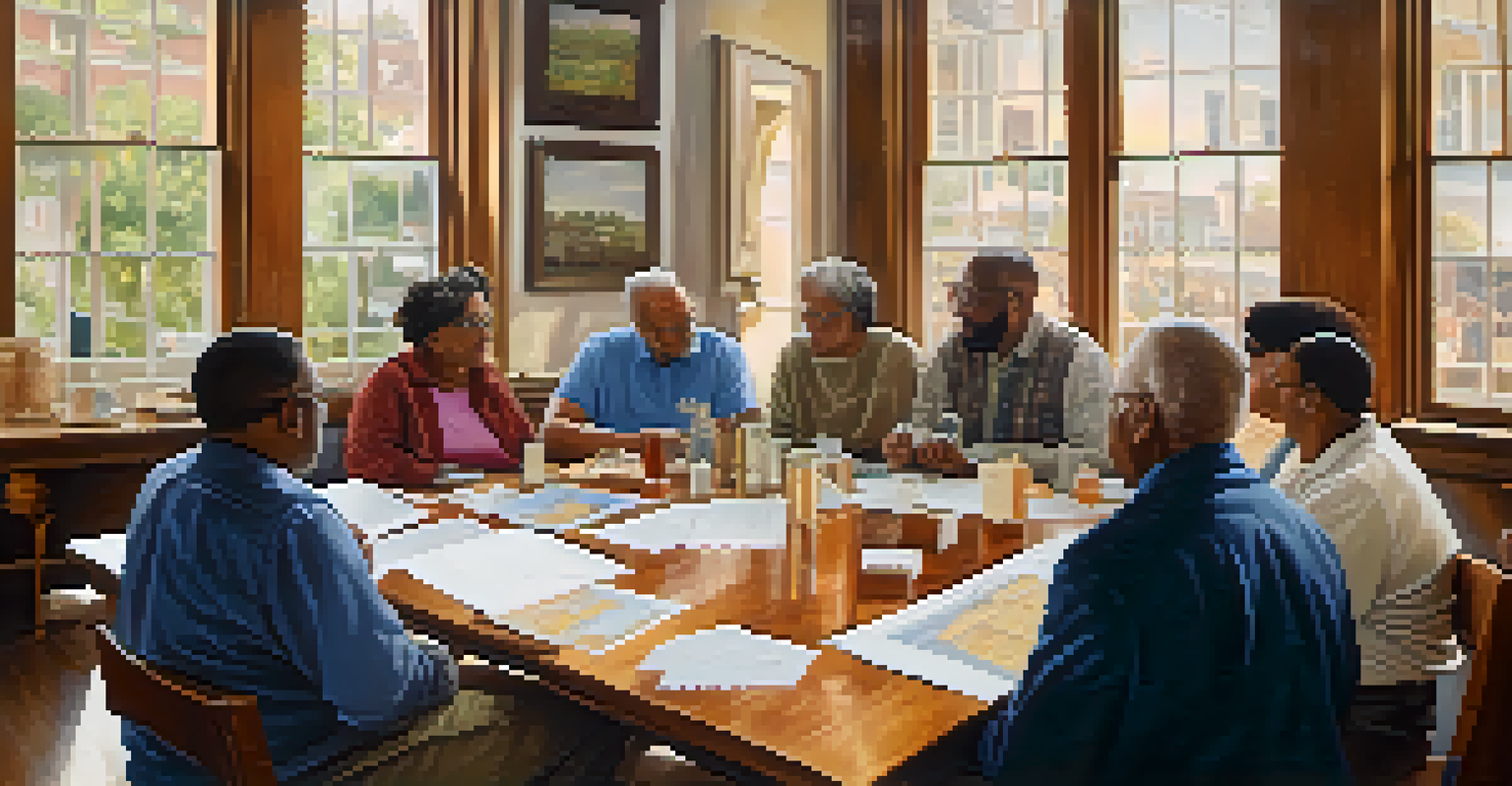Key Legislation Impacting Historic Preservation in San Francisco

The Importance of Historic Preservation in San Francisco
San Francisco is a city rich in history, with its iconic Victorian architecture and landmarks drawing visitors from around the globe. Preserving these structures is not just about maintaining aesthetics; it’s about retaining the cultural identity and stories they embody. Historic preservation ensures that future generations can appreciate the city’s unique past while fostering a sense of community.
Heritage is not just about buildings; it's about the stories that make a community.
Moreover, preserving historic sites can provide economic benefits, such as increased tourism and property values. Tourists often seek experiences that reflect the local culture, and well-preserved neighborhoods can enhance that appeal. By investing in preservation efforts, San Francisco can continue to thrive as a vibrant city that honors its roots.
In this context, various laws and regulations play a vital role in safeguarding these historical treasures. Understanding the key legislation impacting historic preservation is essential for stakeholders, including homeowners, developers, and city officials, who aim to balance growth with conservation.
The California Environmental Quality Act (CEQA) Explained
The California Environmental Quality Act (CEQA) is a cornerstone of environmental regulation in the state, requiring public agencies to evaluate the environmental impacts of their actions. For historic preservation, CEQA mandates that potential impacts on historic sites be considered before any project is approved. This means that developers must assess how their plans might affect the integrity of historic buildings or districts.

One notable aspect of CEQA is its public participation requirement, allowing community members to voice their opinions on proposed projects. This ensures that the voices of those who cherish San Francisco's history are heard in the decision-making process. For instance, if a new development threatens a historic site, community feedback can lead to modifications or even project cancellations.
Preserving San Francisco's Heritage
Historic preservation is vital for maintaining the cultural identity and community spirit of San Francisco.
CEQA serves as a protective measure, promoting transparency and accountability in urban development. By incorporating historic preservation considerations into the planning process, the act plays a vital role in fostering a harmonious relationship between progress and preservation.
San Francisco's Historic Preservation Ordinance Overview
San Francisco's Historic Preservation Ordinance is a local law that establishes guidelines for protecting the city’s historic resources. This ordinance identifies and designates historical landmarks, districts, and structures, ensuring they receive the necessary protection from demolition or inappropriate alterations. The law reflects the city's commitment to maintaining its unique architectural heritage.
Preservation is a form of sustainability. It’s not just about saving old buildings; it’s about creating a future that respects the past.
Under this ordinance, property owners must obtain a permit before making significant changes to designated historic properties. This process encourages thoughtful renovations that respect the original character of the building. For example, if a homeowner wishes to add a modern extension to a Victorian house, they will need to ensure that the new design harmonizes with the historic elements.
The ordinance also facilitates education and outreach programs, helping residents understand the value of historic preservation. By promoting awareness, San Francisco cultivates a community that values its history and actively participates in protecting its architectural treasures.
The Role of the San Francisco Planning Department
The San Francisco Planning Department plays a crucial role in implementing the city's historic preservation policies. This department is responsible for reviewing projects that might impact historic resources, ensuring compliance with both local and state regulations. Their expertise helps guide developers and property owners through the preservation process, making it easier for them to navigate complex requirements.
Additionally, the Planning Department conducts surveys to identify historic resources that merit preservation. These surveys help inform policy decisions and prioritize resources for protection. By systematically assessing the city’s architectural assets, the department can create a more comprehensive preservation strategy.
CEQA's Role in Preservation
The California Environmental Quality Act ensures that potential impacts on historic sites are considered in urban development projects.
Their work is not just about enforcing laws; it's also about fostering collaboration and communication between stakeholders. By engaging with community members, developers, and preservationists, the Planning Department helps create a shared vision for San Francisco's future that honors its past.
The Mills Act: A Financial Incentive for Preservation
The Mills Act is a significant financial incentive that encourages property owners to preserve their historic homes. This California law allows local governments to enter into contracts with property owners, providing property tax reductions in exchange for maintaining and restoring historic properties. For many homeowners in San Francisco, this can mean substantial savings, making the preservation of their historic homes more financially feasible.
For instance, a Victorian house owner might save thousands of dollars annually on property taxes, which can be reinvested into necessary repairs or restorations. This not only supports the preservation of individual properties but also contributes to the overall character and charm of historic neighborhoods. As these homes are maintained, they continue to attract tourists and residents alike, further enhancing community pride.
The Mills Act thus serves as a win-win solution: property owners benefit financially while the city retains its rich historical tapestry. It’s an example of how economic incentives can align with the goals of historic preservation, creating a sustainable model for maintaining San Francisco's architectural heritage.
Community Involvement in Historic Preservation Efforts
Community involvement is essential to the success of historic preservation in San Francisco. Local organizations, advocacy groups, and neighborhood associations often play a pivotal role in raising awareness about the importance of preserving historical sites. By mobilizing residents, these groups can influence policy decisions and ensure that the voices of the community are reflected in preservation efforts.
For example, grassroots campaigns have successfully rallied support to save at-risk landmarks from demolition. When a historic building is threatened, community members often organize petitions, hold meetings, and engage in outreach to educate others about its significance. This collective action can lead to significant changes in local policy, demonstrating the power of community activism.
Community Engagement Matters
Active community involvement is crucial for influencing preservation policies and fostering pride in San Francisco's historical assets.
Furthermore, community involvement fosters a sense of ownership and pride in the city's history. When residents participate in preservation initiatives, they develop a deeper connection to their neighborhood, leading to a more engaged and informed citizenry. This active participation is key to ensuring that San Francisco's historic fabric is not only preserved but celebrated.
Challenges Facing Historic Preservation in San Francisco
While San Francisco has made strides in historic preservation, challenges persist in balancing development with conservation. As the city continues to grow and evolve, the demand for new housing and commercial spaces often conflicts with the need to protect historic sites. Developers may see old buildings as obstacles to progress, leading to tensions between preservation advocates and those seeking to modernize the city.
Additionally, funding for preservation projects can be limited, making it difficult to maintain and restore historic sites adequately. Many historic properties require significant investment to rehabilitate, and without financial support, some may fall into disrepair. This situation can lead to a vicious cycle where neglect jeopardizes a building's historical integrity, making it an easier target for demolition.

Moreover, changing demographics and socioeconomic factors can pose a threat to historic neighborhoods. As property values rise, long-standing residents may be pushed out, leading to a loss of the very culture and community that historic preservation seeks to protect. Addressing these challenges requires innovative solutions and a commitment from all stakeholders to find a balance between progress and preservation.